Suspended scaffolding is a temporary work platform hanging from a higher support structure like a ceiling or roof through chains, cables, ropes, or other non-rigid means. Platforms suspended by ropes are used to allow workers to access difficult-to-reach areas with ease on a high-rise construction site or tall buildings. This temporary structure features essential safety measures such as guardrails and toeboards to protect against falls. The suspended scaffold design has limited load-bearing capacity with optimal height safety measures, so workers can perform repair and maintenance tasks safely at different heights.
The main types of suspended scaffolding are single-point adjustable scaffolds, two-point adjustable scaffolds, and multi-point adjustable scaffolds. The main benefits of suspended scaffolding are cost-effectiveness, lightweight and portable structure, less material requirement, and space-saving. The main uses of suspended scaffolding are in building facades, window installation and maintenance, industrial site maintenance, and heritage building restoration.
Table of Contents
What is Suspended Scaffolding?
Suspended scaffolding is a specialized system that involves a platform that is hung from an overhead structure using ropes, chains, or wire cables. Suspended Scaffolding is commonly used for tasks such as painting, cleaning, or maintenance on high-rise buildings or other vertical structures. One of the key advantages of suspended scaffolding is its ability to provide access to hard-to-reach areas without the need for a base on the ground.
The platform’s height can be easily adjusted using a pulley or winch system, allowing workers to move up or down easily and precisely. Suspended scaffolding is lightweight, making it easy to transport and set up on-site. Its design is tailored for flexibility and efficiency, ensuring workers can perform their tasks comfortably and safely at various heights. This type of scaffolding is highly valued for its ability to provide access in situations where traditional scaffolding would be impractical, offering both convenience and reliability.
What is the Diagram of Suspended Scaffolding?

Suspended Scaffolding Images


How much is the rental for suspended scaffolding in the UAE?
The rental cost of suspended scaffolding in the UAE depends on the following factors:
- Size of platform
- Location
- Project duration
- Additional equipments
- Delivery and installation
- Insurance coverage
Size of platform: You will pay more for a large platform.
Location: Renting scaffolding in urban areas will be more expensive, as there are strict regulations and limited access. You may need to get additional permits.
Project Duration: The rental cost of duration will be lower when you plan to rent it for a long time.
Additional equipment: You will pay more if you need equipment such as a safety harness, debris nets, hoist, etc.
Delivery and installation: Another factor contributing to the overall cost of renting suspended scaffolding in the UAE is installing, delivering, and dismantling the scaffold structure.
Insurance: Some rental companies require you to get coverage that will increase your rental cost.
What are the types of Suspended Scaffolding?
The eight types of suspended scaffolds are as follows:
- Single-point Adjustable scaffold
- Two-point adjustable scaffold
- Multi-Point adjustable scaffold
- Catenary scaffold
- Float scaffold
- Interior hung scaffold
- Multi-level suspended scaffold
- Boatswain’s Chair
1. Single Point Adjustable Scaffold:

This type of suspended scaffolding is generally used for light maintenance work on buildings and window washing. It supports a single rope or cable suspension. Workers can raise the lower platform to various heights. It can also rotate and swing to provide easy access to difficult areas.
2. Two-point Adjustable scaffolding:

Two-point adjustable scaffolding features a platform suspended through ropes and cables at two points. This type proves useful for tasks where workers need to work on exterior building walls, such as repair, painting, and window washing.
3. Multi-Point Adjustable Scaffold:
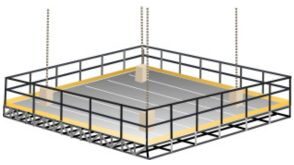
Multi-point adjustable scaffolds comprise multiple cables and ropes supporting large, more stable platforms. You can adjust the height of this structure at different levels. This type of scaffold is helpful in painting and repairing long facades.
4. Catenary Scaffolding:

Catenary scaffolding has a platform supported by a series of ropes configured in a catenary curve. This type of suspended scaffolding proves helpful in the industrial setting where direct vertical support is not feasible. The scaffold framework must be suspended over large machinery, tanks, or difficult areas. It offers wide-span gaps and a stable workspace.
5. Float Scaffolding:

Float scaffolding has a platform suspended through a fixed-length wire or rope supported by a beam parallel to the structure. Scaffolds can move horizontally along the beam and let workers enjoy easy access to the length of the structure. This type of scaffolding is helpful for facade maintenance and window installation.
6. Interior Hung Scaffolding:

Interior hung scaffolding consists of platforms suspended through wires or ropes from an overhead support beam inside the structure. This type of suspended scaffolding is used in interior spaces such as churches, theatres, etc.
7. Multilevel Scaffolding:
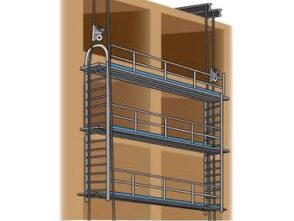
Multilevel scaffolding has multiple suspended platforms that can be raised or lowered independently. It is ideal for complex construction or maintenance tasks where workers must simultaneously work at various levels.
8. Boatswain’s Chair:

Boatswain’s chair is the simplest form of suspended scaffolding designed for only one worker who can use this chair to complete the tasks. It is also known as Bosun’s chair. It helps handle light tasks such as inspection, minor repairs, and window washing.
What are the Benefits of Suspended Scaffolding?
The seven benefits of suspended scaffolding are as follows:
- Lightweight and Portable
- Less Material Needed
- Customizable
- Efficient Workflow
- Cost-Effective
- Safe Access
- Space-Saving
1. Lightweight and Portable
The biggest benefit of suspended scaffolding is that it is lightweight compared to traditional scaffolding. It doesn’t require multiple types of frame or heavy base material. Its lightweight structure makes it portable, which is especially useful for high-rise construction, where portability is vital.
2. Less Material Needed
Another plus point of suspended scaffolding is that it requires less material. There is no ground base, and vertical supports are needed. Low material requirements reduce the initial setup cost and simplify the logistics and installation.
3. Customizable
The biggest advantage of using suspended scaffolds is that they offer a high degree of customization. You can change platform length, width, and configurations so that they align well with your project requirements. This allows workers to access difficult-to-reach areas without needing any kind of heavy scaffold.
4. Efficient Workflow
Another plus point of suspended scaffolding is that workers get direct access to their workspace from above. They don’t need to reposition the structure or climb. As a result, they can move and do their work on the exterior of buildings easily. There is no need to descend to the ground level, and no disposition is required. Crew can complete tasks at hand with speed and efficiency.
5. Cost-Effective
Suspended scaffolding proves cost-effective, especially during large-scale construction. First, it requires less material to build. The setup is quick and straightforward, leading to low labour costs. Less time is required to install or dismantle this structure. You can customize it according to your project specification, so it causes less waste or more efficient use of resources.
6. Safe Access
When workers need to access difficult-to-reach areas or high elevations, suspended scaffolds prove quite beneficial. They allow crews to access hard-to-reach spots safely and get a stable platform to work at elevated heights. They are designed with security features such as guardrails and toeboards to reduce the risk of fall accidents. They offer safer access than traditional scaffolding structures.
7. Space-Saving
One of the significant benefits of suspended scaffolding is that it is a space-saving temporary structure. Swing stage scaffolds take less ground space, which proves quite useful in crowded urban areas projects. They allow construction managers to keep the ground clear as there is no large scaffolding base they need to install. As a result, there is minimal disruption at the ground, while workers still enjoy a great deal of accessibility to construction or maintenance sites.
What are Disadvantages of Suspended Scaffolding?
The eight disadvantages of suspended scaffolding are as follows:
- Limited to High-Rise Buildings
- Not Suitable for Heavy Construction
- Low Surface Coverage
- High Loading Restrictions
- Complex Setup
- Weather Sensitivity
- Wind Sensitivity
- Higher Setup Costs
1. Limited to High-Rise Buildings
The biggest drawback of suspended scaffolds is their unsuitability for low-rise buildings. They are designed for only high-rise buildings and tall structures where you need to anchor the structure from above. They can’t be used for projects that don’t have significant heights. Therefore, they are helpful only for urban settings and high-rise projects and unsuitable for other construction projects.
2. Not Suitable for Heavy Construction: Suspended scaffolds have limited load capacity and must be more suitable for heavy-load construction. You can’t use a scaffold when a project requires extensive facade renovations requiring heavy cladding material. They can bear loads of large-scale masonry.
3. Low Surface Coverage: Another disadvantage of suspended scaffolding is its low surface coverage. Conversely, workers can access wide and tall areas with traditional scaffolding. It is time-consuming for workers to reposition the scaffold to access other exterior areas of the building, and this adjustment works efficiently.
4. High Loading Restrictions: Workers must adhere to load limits with suspended scaffolding. This structure’s structure is its high loading restriction. Careful planning is required regarding load weights because exceeding the limit will lead to security risks. Workers should constantly monitor the weight limit to prevent unfortunate incidents.
5. Complex Setup: The setup of a suspended load is complex and requires skilled personnel. An expert installer needs to secure the anchor balance to ensure that the suspended scaffold is installed properly. Any error or mistake during the setup process will increase significant security risks.
6. Weather Sensitivity Another disadvantage of suspended scaffolding is that it remains highly vulnerable to extreme weather conditions such as rain, snow, heavy wind, etc. Harsh weather can create dangerous work scenarios for workers as tools or materials can fall from the height, causing the platform to sway.
7. Wind Sensitivity Another drawback of suspended scaffolding is that it is highly wind-sensitive. This structure hangs from above, and moderate winds can induce swinging and pose serious safety risks. Workers need help continuing to do their regular tasks during heavy wind scenarios.
8. Higher Setup Costs The Overall setup cost of a suspended scaffold is high. Many factors contribute to this high cost. First, it needs specialized equipment and skilled labour. Once the setup is done, rigorous checks need to be performed to ensure that the complete setup is safe for workers’ use.
What are the uses of Suspended Scaffolding?
The ten uses of suspended scaffolding are as follows:
- Building Facades
- Window Installation and Cleaning
- Bridge Maintenance
- Industrial Maintenance
- Tower and Wind Turbine Maintenance
- Ship Maintenance
- Heritage Building Restoration
- Ceiling Renovations
- Billboard Installation
- Exterior Cleaning Tasks.
1. Building Facade

Suspended scaffolding is mainly used to inspect, maintain and clean building faces. The facade accumulates dirt and pollution over time, and workers access the exterior of the building through this temporary structure and perform cleaning tasks across the entire height and width of the building using tools like pressure washers, scrapers, and chemical cleaners. Inspectors use suspended structures to inspect the building’s exterior and check the facade for any wear, tear, or potential damage. Maintenance tasks such as minor repair, repointing mortar joints, sealing cracks, etc, are done at various heights using a suspended scaffold.
2. Window Installation and Cleaning

Another common use of suspended scaffolding is window installation and cleaning. Workers use a swing stage to fit the window frame in the facade structure. They install the windows and ensure that they are sealed properly. They are also used to clean windows of high-rise structures. This cleaning is crucial for maintaining the building’s aesthetic value, and cleaners rely on suspended scaffolding to perform tasks with ease and speed.
3. Bridge Maintenance

Suspended scaffolding is also used in the bridge maintenance process. Inspectors use a swing stage to inspect the bridge’s facade for wear, tear, or damage. Later, they hire workers who can address the damages caused by environmental exposure. Workers perform painting, minor repairs, or sealing bridge facades. This regular maintenance increases the lifespan of bridges and boosts infrastructure safety.
4. Industrial Maintenance

Another use of suspended scaffolding is in industrial maintenance tasks. Workers use swing space during surface cleaning, structural element repair, and maintenance of industrial ventilation systems.
5. Tower and Wind Turbine Maintenance

Suspended scaffolding is also used to maintain the external surfaces of towers and wind turbines. Workers use a scaffold platform to complete tasks such as painting, composite material repair, and bolt tightening.
6. Ship Maintenance

Suspended scaffolds are also useful in various ship maintenance tasks. Workers perform regular inspections and address issues like corrosion and other damages. They also prove useful during the application of protective coatings on the ship’s facade and cleaning its exterior to maintain its aesthetic appeal.
7. Heritage Building Restoration

Suspended scaffolding proves quite useful in heritage building restoration. Renovations of historic buildings are sensitive as workers need to clean, repair, or replace the facade elements without compromising the architectural integrity of the structure. They need to match the material with the original as closely as possible, and this task can be done with precision and without damaging ground level with a suspended platform.
8. Ceiling Renovations

Suspended scaffolds are used during ceiling renovation and remodelling tasks in tall structures. Workers stand on the swing stage and install acoustic panels, decorative elements, and other things on the walls, interiors, and ceilings.
9. Billboard Installation

Suspended scaffolds are also used during the billboard installation process.
10. Exterior Cleaning Tasks

Suspended scaffolds are also useful in cleaning entire facades. Over time, dirt, grime, pollutant deposits, and biological growth on the facade lead to material degradation. Workers deep clean the facade to prevent degradation and keep the area sparkling.
What are the parts of Suspended Scaffolding?
The twelve parts of suspended scaffolding are as follows:
- Platform
- Support Cables
- Stirrups
- Hoist
- Guardrails and Toeboards
- Counterweights
- Safety Harness and Lanyards
- Outriggers
- Tie Backs
- Electric Motors
- Pulleys
- Anchors
1.Platform
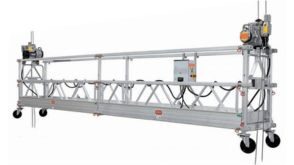
The platform is the most crucial part of the suspended scaffold system. Workers stand in this main work area and do their regular tasks. The platform is made from durable and lightweight materials. The exact size of the platform depends on the project requirement, but it should be strong enough to hold the weight of tools, materials, and workers.
2.Support Cables
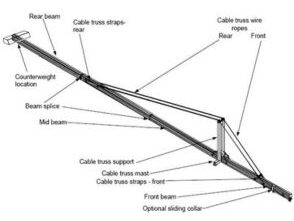
Support cables are high-tensile strength steel cables used to suspend the scaffold platform from the overhead structure. They maintain scaffold stability and safety. Inspectors need to inspect these cables regularly so issues like wear, corrosion, and damage can be fixed on time.
3.Stirrups
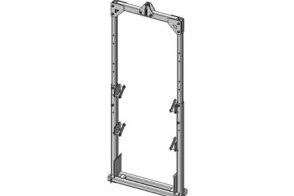
Stirrups are U-shaped brackets that connect support cables to scaffold platforms. They allow easy platform height adjustment and play an important role in the overall levelling and stability of the swing stage.
4.Hoist
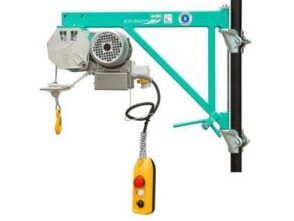
A hoist is a device used to raise or lower the scaffold platform. It can be operated manually or through electricity. The hoist mechanism comprises gears, brakes, and other parts and ensures smooth platform movement.
5.Guardrails and Toeboards

Guardrails are safety rails installed at the edge of the platform. These safety measures prevent workers from accidentally stepping out of the platform. Toeboards are raised edges around the bottom of the platform. These boards ensure that tools and materials don’t fall from the platform or cause damage or injuries on the ground.
6.Counterweights
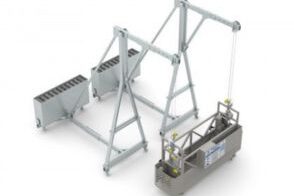
Counterweights are weights placed on the opposite side of the rigging system. They balance the load of the scaffold and ensure the stability of a non-anchored suspended system.
7.Safety Harness and Lanyards

The safety harness is a full-body harness that workers wear. This harness distributes the force of a fall across the body and protects the workers by keeping them upright. It prevents them from hitting the ground. The lanyard connects the harness to an anchor point and reduces the risk of injury by arresting a fall. Safety harnesses and lanyards are essential to the personal fall arrest system. The primary purpose of these components is to ensure that workers can be caught safely if a fall occurs.
8.Outriggers
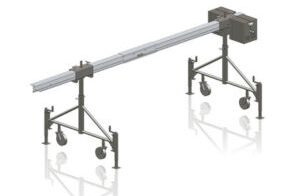
Outriggers are beams that extend horizontally from the building. They distribute the weight of the scaffold away from the building’s edge. They often bear the counterweight and support the load of scaffolding.
9.Tie Backs

Tiebacks are ropes or cables that tie scaffolds to a sturdy part of the building. They are used to secure the scaffold to the building. These additional safety features of the scaffold increase the stability and security of the swing stage and prevent it from swaying.
10.Electric Motors
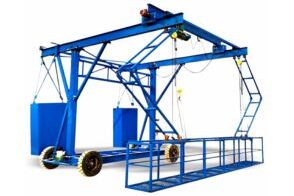
Electrical motors power the hoist to raise or lower the scaffolding platform. These motors should be strong enough to hold the load. Another essential feature of electric motors is their durability; they must withstand various construction environments,
11.Pulleys
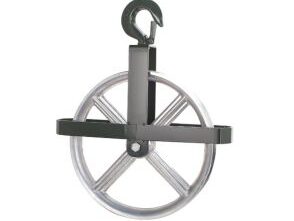
Pulleys are the mechanical system of a suspended scaffold. They let the hoist function properly by guiding the support cables. They also allow smooth raising and lowering of the platform.
12.Anchors

Anchors are fixed points on the building to which the scaffolding system is secured. They should be firm and rough to hold the weight of the scaffold and the dynamic load usually applied to them during scaffolding use.






